
|
Astronomy Picture Of the Day (APOD)
 Microquasar in Motion
Microquasar in Motion
16.09.2004
Microquasars, bizarre binary star systems, generating high-energy radiation and blasting out jets of particles at nearly the speed of light, live in our Milky Way galaxy. The energetic microquasar systems seem to consist...
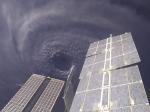 Above the Eye of Hurricane Ivan
Above the Eye of Hurricane Ivan
15.09.2004
Ninety percent of the houses on Grenada were damaged. Such is the destructive force of Hurricane Ivan, already one of the most powerful and destructive hurricanes on record. And the storm will likely make landfall in southern USA tomorrow.
 Genesis Missions Hard Impact
Genesis Missions Hard Impact
14.09.2004
A flying saucer from outer space crash-landed in the Utah desert last week after being tracked by radar and chased by helicopters. No space aliens were involved, however. The saucer, pictured above...
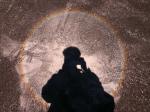 Identify this Phenomenon
Identify this Phenomenon
13.09.2004
What caused this ring of colors? At the time of this writing, MIT Physics Professor Walter Lewin had yet to find someone who can give the correct explanation. Not students. Not colleagues. Not APOD editors. He wonders how the astute readers of APOD will do. Can you match wits with Professor Lewin?
 Mercury: A Cratered Inferno
Mercury: A Cratered Inferno
12.09.2004
Mercury's surface looks similar to our Moon's. Each is heavily cratered and made of rock. Mercury's diameter is about 4800 km, while the Moon's is slightly less at about 3500 km (compared with about 12,700 km for the Earth). But Mercury is unique in many ways.
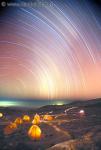 The Star Trails of Kilimanjaro
The Star Trails of Kilimanjaro
11.09.2004
The night had no moon, but the stars were out. And camped at 16,000 feet on Mt. Kilimanjaro, photographer Dan Heller recorded this marvelous 3 1/2 hour long exposure. Here the landscape is lit mostly by the stars.
 Cat s Eye
Cat s Eye
10.09.2004
Staring across interstellar space, the alluring Cat's Eye nebula lies three thousand light-years from Earth. A classic planetary nebula, the Cat's Eye (NGC 6543) represents a final, brief yet glorious phase in the life of a sun-like star.
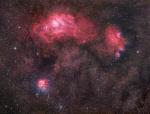 Sagittarius Triplet
Sagittarius Triplet
9.09.2004
These three bright nebulae are often featured in telescopic tours of the constellation Sagittarius and the view toward the center of our Milky Way galaxy. In fact, 18th century cosmic tourist Charles Messier cataloged two of them; M8, the nebula above and left of center, and colorful M20 at the lower left.
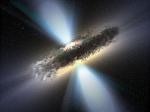 Molecular Torus Surrounds Black Hole
Molecular Torus Surrounds Black Hole
8.09.2004
Why do some black hole surroundings appear brighter than others? In the centers of active galaxies, supermassive black holes at least thousands of times the mass of our Sun dominate. Many, called Seyfert Type I, are very bright in visible light. Others, called Seyfert Type II, are rather dim.
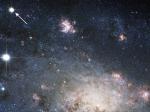 A Supernova in Nearby Galaxy NGC 2403
A Supernova in Nearby Galaxy NGC 2403
7.09.2004
The closest and brightest supernova in over a decade was recorded just over a month ago in the outskirts of nearby galaxy NGC 2403. Officially tagged SN 2004dj, the Type IIP explosion likely annihilated most of a blue supergiant star as central fusion could no longer hold it up.
|
January February March April May June July August September October November December |
||||||||||||||||||||||||||||||||||||||||||||||||||||||||